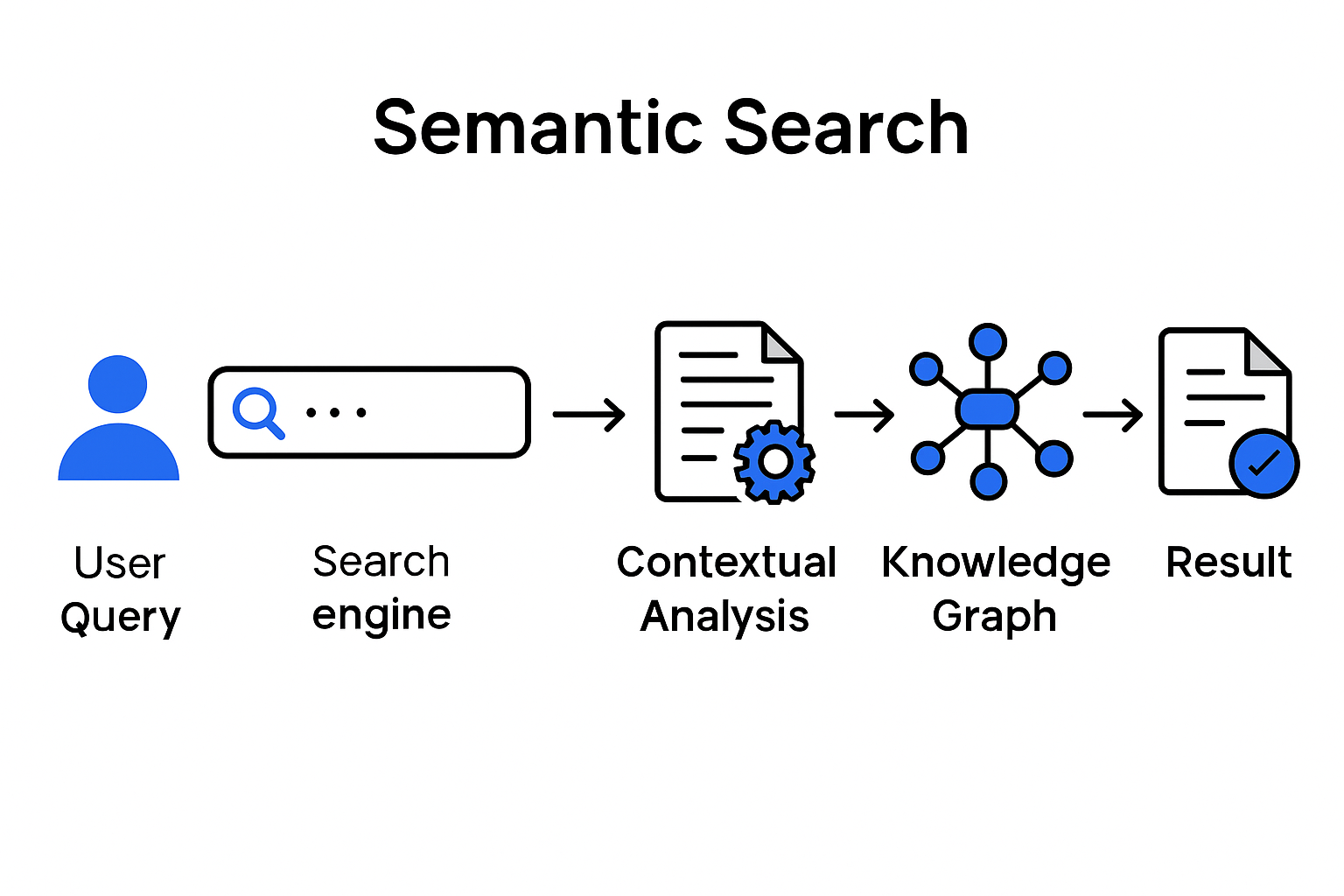Semantic search is quietly rewriting the rules of how people find answers online. Search engines now look far past matching words and focus instead on the meaning behind every query. And get ready for a reality check. Traditional SEO tricks like keyword stuffing are fading fast. What really matters is intent and depth. Sites that embrace this shift are seeing bold results. For example, JD.com saw a 10.03 percent jump in conversion rates on long-tail searches after implementing semantic search. Surprised? That’s just the start of what’s possible when you unlock the true power of semantic SEO.
Table of Contents
- What Is Semantic Search And How It Works
- Why Semantic Search Matters For Modern SEO
- Key Strategies To Optimize For Semantic Search
- Real-World Examples And Actionable Tips
Quick Summary
| Takeaway | Explanation |
|---|---|
| Optimize content for user intent | Focus on creating content that addresses user questions and needs comprehensively. |
| Implement structured data markup | Use schema.org to improve content visibility and interpretation by search engines. |
| Utilize semantic relationship mapping | Connect related concepts within content for better relevance and discoverability. |
| Develop comprehensive topic coverage | Create in-depth articles that explore various angles to enhance semantic richness. |
| Adjust technical SEO practices | Improve site architecture and internal linking to align with semantic search principles. |
What Is Semantic Search and How It Works

Semantic search represents a sophisticated approach to information retrieval that goes far beyond traditional keyword matching. Unlike conventional search methods that simply scan for exact word matches, semantic search understands the context, intent, and deeper meaning behind user queries.
The Core Principles of Semantic Understanding
At its foundation, semantic search leverages advanced natural language processing techniques to decode the nuanced relationships between words and concepts. Microsoft Research highlights that these neural language models can comprehend complex linguistic structures, interpreting queries with remarkable contextual accuracy.
The process involves multiple sophisticated mechanisms. Contextual analysis examines the surrounding words and phrases to determine precise meaning. Taxonomic mapping connects related concepts, allowing search systems to understand synonyms and conceptual relationships. Knowledge graph integration further enhances this by creating interconnected webs of information that reflect real-world semantic connections.
To help clarify the core mechanisms of semantic understanding, the following table summarizes their functions and roles:
| Mechanism | Function | Role in Semantic Search |
|---|---|---|
| Contextual Analysis | Examines surrounding words and phrases | Determines precise meaning and intent |
| Taxonomic Mapping | Connects related concepts | Understands synonyms and conceptual relationships |
| Knowledge Graph Integration | Creates interconnected webs of information | Reflects real-world semantic connections |
Technical Mechanisms Driving Semantic Search
Semantic search employs complex algorithmic approaches to understand user intent. According to academic research in information science, these techniques include:
- Lexical Variant Recognition: Understanding different word forms and linguistic variations
- Query Contextualization: Analyzing previous searches and user location to refine results
- Machine Learning Adaptation: Continuously improving search relevance through intelligent pattern recognition
The technology interprets queries as meaningful communication rather than simple string matches. For instance, when a user searches “best coffee near me,” a semantic search system understands the implicit request for local recommendations, geographical proximity, and quality indicators.
By integrating natural language processing, machine learning, and semantic web technologies, these advanced search systems deliver more intelligent and precise results. They can distinguish between ambiguous terms, understand user intent, and provide contextually relevant information that goes well beyond traditional search capabilities.
The evolution of semantic search represents a significant leap in how we interact with digital information. Instead of receiving a list of potentially irrelevant links, users now experience more intuitive, intelligent search experiences that feel almost conversational in their precision and understanding.
As artificial intelligence continues to advance, semantic search will become increasingly sophisticated, bridging the gap between human communication and machine comprehension with unprecedented accuracy and nuance.
Why Semantic Search Matters For Modern SEO
In the rapidly evolving digital marketing ecosystem, semantic search has become a critical component for successful SEO strategies. Search Engine Journal explains that search engines now prioritize understanding user intent and context over simple keyword matching, fundamentally transforming how content is discovered and ranked.
The Changing Landscape of Search Engine Algorithms
Modern search algorithms have shifted from literal interpretation to comprehensive contextual understanding. Wikipedia highlights that semantic search seeks to improve search accuracy by interpreting the deeper meaning behind search queries. This means search engines now analyze the relationships between words, user intent, and the broader context of information.
Traditional SEO approaches focused on keyword density and exact match phrases are becoming obsolete. Instead, content creators must develop rich, meaningful content that addresses user questions comprehensively. Semantic relevance has replaced keyword stuffing as the primary metric for content quality.
The table below offers a quick comparison between traditional SEO and semantic SEO as described in the content:
| Aspect | Traditional SEO | Semantic SEO |
|---|---|---|
| Focus | Keyword density, exact match | User intent, contextual relevance |
| Content Approach | Short-form, keyword-stuffed | Comprehensive, in-depth, natural language |
| Optimization Metric | Keyword stuffing | Semantic relevance |
| Ranking Mechanisms | Literal interpretation | Contextual understanding |
Strategic Implications for Content Creators
Content optimization now requires a more nuanced approach. Writers must:
- Understand User Intent: Create content that thoroughly addresses potential user questions
- Build Contextual Depth: Develop comprehensive content that explores topics from multiple angles
- Use Natural Language: Write in a conversational manner that reflects how people actually communicate
These strategies ensure content aligns with semantic search principles, increasing the likelihood of ranking higher in search results. Learn more about optimizing your content strategy.
The impact extends beyond simple ranking. Semantic search enables more intelligent content discovery, allowing websites to reach audiences more precisely. Search engines can now match user queries with content that might not contain exact keyword matches but provides genuine value and relevance.
Businesses that adapt to semantic search principles gain significant competitive advantages. They can create more targeted content, improve user experience, and potentially increase organic traffic by providing more meaningful and contextually relevant information.
As artificial intelligence and machine learning continue to advance, semantic search will become even more sophisticated. Early adopters who understand and implement these principles will be best positioned to succeed in the evolving digital marketing landscape.
Key Strategies to Optimize for Semantic Search
Optimizing for semantic search requires a comprehensive approach that goes beyond traditional SEO techniques. Content creators and digital marketers must develop sophisticated strategies that align with advanced search engine algorithms and user intent.
Structured Data and Semantic Markup
Research from semantic search studies emphasizes the critical importance of structured data and metadata vocabularies. Semantic markup provides search engines with explicit context about content, enabling more accurate interpretation and representation in search results.
Implementing schema.org structured data helps search engines understand the precise meaning of content. This includes adding detailed annotations for articles, products, events, and other content types. By providing clear, machine-readable information, websites can significantly improve their visibility and relevance in semantic search results.
Advanced Content Optimization Techniques
Linguistic research reveals that semantic query expansion techniques can dramatically enhance content discoverability. These methods involve:
- Comprehensive Topic Coverage: Create in-depth content that explores multiple facets of a subject
- Natural Language Integration: Use conversational and contextually rich language
- Semantic Relationship Mapping: Connect related concepts and ideas within content
The goal is to develop content that answers user questions comprehensively and demonstrates deep topical expertise. Explore advanced content optimization strategies.
Keyword research must evolve from exact match approaches to understanding semantic relationships. This means exploring related terms, synonyms, and conceptual variations that provide a more holistic view of a topic.
Technical Implementation of Semantic Search Optimization
Technical SEO plays a crucial role in semantic search optimization. Advanced search indexing research suggests implementing semantic-enhanced search indices that go beyond traditional keyword matching.
Website owners should focus on:
- Improving internal linking structures
- Creating comprehensive, interlinked content clusters
- Developing clear site architecture that reflects semantic relationships
- Ensuring mobile responsiveness and fast loading times
The future of SEO lies in understanding and anticipating user intent. By creating rich, contextually relevant content and implementing advanced semantic optimization techniques, websites can dramatically improve their search engine performance.
As search algorithms become more sophisticated, those who master semantic search principles will gain significant competitive advantages in digital visibility and user engagement.
Real-World Examples and Actionable Tips
Semantic search strategies are not just theoretical concepts but powerful tools that can dramatically transform digital marketing and search performance. Real-world case studies demonstrate the tangible impact of implementing sophisticated semantic search optimization techniques.
E-commerce Search Transformation
Research from a 2025 semantic search study reveals groundbreaking approaches in e-commerce search refinement. By demoting semantically equivalent queries and enhancing autocomplete suggestions, businesses can significantly improve user experience and conversion rates.
For instance, a comprehensive study on personalized e-commerce search showcased remarkable results. When JD.com implemented an advanced semantic retrieval model, they experienced a 1.29% overall conversion rate improvement, with a stunning 10.03% increase for long-tail queries. This underscores the power of understanding semantic nuances in search algorithms.
To illustrate the impact of semantic search in practice, the following table summarizes the key statistics from the JD.com case study:
| Scenario | Conversion Rate Improvement |
|---|---|
| Overall (all queries) | 1.29% |
| Long-tail searches | 10.03% |
Practical Implementation Strategies
Successful semantic search optimization requires a multifaceted approach. Content depth and topical comprehensiveness become critical factors. A case study by industry experts demonstrated how strategic content expansion can transform search rankings:
- Comprehensive Topic Coverage: Develop content that explores multiple angles of a subject
- Semantic Interlinking: Create meaningful connections between related content pieces
- User Intent Mapping: Anticipate and address potential user questions
One remarkable example showed a page about keyword cannibalization improving from position 19 to 5 in Google rankings, increasing organic traffic by 677% and ranking for 70% more keywords. Learn more about advanced SEO strategies.
Technical Optimization Techniques
Beyond content strategies, technical optimization plays a crucial role. Website owners should focus on:
- Implementing structured data markup
- Developing clear, semantically rich content architectures
- Utilizing schema.org vocabularies
- Creating comprehensive internal linking strategies
The key is to think beyond traditional keyword optimization. Search engines now prioritize content that demonstrates genuine expertise, contextual understanding, and comprehensive topic coverage.

Businesses and content creators who embrace these semantic search principles will not just improve their search rankings but create more valuable, user-centric digital experiences. As artificial intelligence continues to evolve, the ability to understand and leverage semantic search will become an increasingly critical competitive advantage.
The future of search is not about matching keywords but about understanding intent, context, and the intricate relationships between ideas. Those who master this approach will lead in digital visibility and user engagement.
Frequently Asked Questions
What is semantic search and how does it work?
Semantic search is an advanced approach to information retrieval that understands the context, intent, and deeper meaning behind user queries, rather than relying solely on keyword matching. It utilizes techniques such as contextual analysis, taxonomic mapping, and knowledge graph integration to improve search accuracy.
Why is semantic search important for SEO in 2025?
Semantic search is crucial as it shifts the focus from traditional keyword strategies to understanding user intent and context. This transformation significantly affects how content is discovered and ranked, making it essential for businesses to create meaningful, relevant content that meets user needs.
How can I optimize my content for semantic search?
To optimize for semantic search, focus on creating content that addresses user intent comprehensively. Implement structured data markup, utilize natural language, and connect related concepts within your content to enhance its relevance and discoverability.
What are some key strategies for implementing semantic search in my website’s SEO?
Key strategies include using structured data for better search engine interpretation, creating in-depth and topic-rich articles, improving internal linking structures, and ensuring that your site architecture reflects semantic relationships. This approach helps enhance both visibility and relevance in search results.
Tired of Keyword Chaos Blocking Your Semantic SEO Breakthrough?
You just learned how semantic search is changing the rules for SEO success. But as you work to build in-depth content and enhance topic coverage, hidden keyword cannibalization can quietly undermine your results. Competing pages and poorly mapped topics dilute your authority in the eyes of advanced search engines that now focus on contextual meaning and user intent. You need clarity before semantic optimization can pay off.
Take back control and unlock your site’s true potential with RankAligner Keyword Cannibalization Tool. Discover how you can quickly spot keyword conflicts and eliminate ranking confusion. When you fix duplication and align your content with semantic principles, you pave the way for stronger rankings and more relevant traffic. Get started today at RankAligner and experience SEO with total confidence. Need a full guide on advanced site optimization? Check out our expert content on optimizing your strategy.

